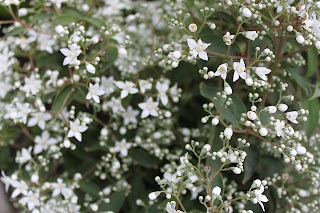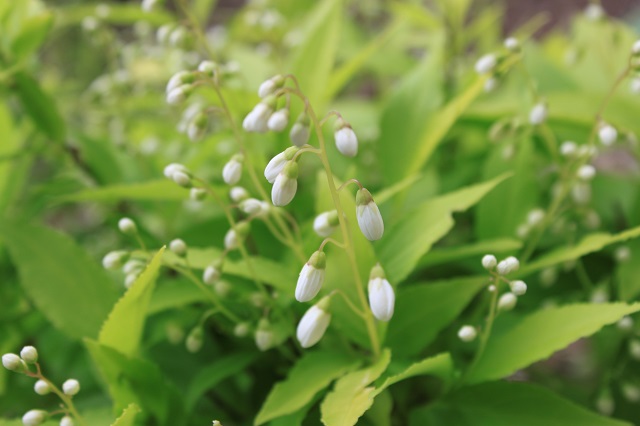GBBG has no shortage of cool plants. There were far too many for me to talk about, so here are some of my favorites that I haven't seen before or are just not real common.
![]()
First up was a pair of
Pinus sylvestris 'Mitch's Weeping' flanking the path just outside of the visitor's center. Despite their susceptibility to pine needle scale and European pine sawfly, I like scotch pine quite a bit. It has beautiful orange flaky bark and great needle color, and this weeping variety shows off both to great effect! I can't wait to see them get bigger!
Next up
Calycanthus 'Hartlage Wine', a wonderful hybrid between
C. floridus and
C. chinensis, was still in bloom with huge rosy colored flowers
. Some references state a mild fragrance, but detected none at all. The flowers are much larger than
C. floridus and lighter colored, foliage is similar to both parents. The plant at GBBG seems to be performing quite well, and was nearly 8' tall x 6' wide. After finally seeing one, this is definitely a future addition to the catalog!
In the orchard remnant I came across one of my favorite under-used shrubs. Variegated Five-Leaf Aralia,
Eleuthrococcus sieboldianus 'Variegatus', is a wonderful addition to any shade or partial shade garden. The variegated foliage helps brighten up dark corners. It can grow to be about 6-8 tall x 6' wide and has a somewhat arching habit. Some selective pruning when young will make it a bit more dense. Greenish-white flowers appear in spring, but are not showy. This is a very adaptable and easy-care shrub that deserves more use. It will hopefully be added to the 2013 catalog.
Also in the orchard remnant
Geranium yoshinoi 'Confetti' was happily taking up real estate as a seeding groundcover. A very cute species with small pink flowers and subtly variegated foliage. From the fact that it was pretty much everywhere in this section of the garden, it's apparent that this little cutie needs post-flowering birth control. It could make a great ground-cover under larger shrubs or small trees. It apparently comes true from seed, so it could be useful for breeding other variegated Geraniums as well. Any interest in us adding this one?
I loved this combination of
Rhus typhina 'Tiger Eyes' and
Agastache 'Bolero'. 'Tiger Eyes' will spread and take up lots of room eventually, but the color and texture of it is amazing. 'Bolero' makes a great filler plant since its a very airy variety and doesn't take up a lot of real estate. It looks to be doing quite well in Green Bay, definitely a zone 5 hardy variety. As with all
Agastache, good drainage is a must.
Thriving in the orchard was Chinese wild ginger
Asarum splendens, a plant that is often listed as zone 6. With rich, well-drained soil it makes it through our zone 5 winters just fine. Winter mulch may be helpful as the foliage is semi-evergreen. Clean up the bad foliage in spring to make room for new growth. I found this species to be somewhat slow for me, but others report it being vigorous. I think our winters probably slow it down a bit, but it still makes a great groundcover for the shade.
Sambucus 'Black Lace' was looking great. Another great shrub from Proven Winners. This one can be a fast-growing beast- plant it carefully- it will reach 10-12' tall and wide quickly! Plant it in partial shade for best color. It might get some die-back in the winter, just prune it off to new growth in spring and it will quickly recover.
Athyrium 'Ghost' is a fantastic hybrid between Japanese painted fern
A. nipponicum pictum and lady fern
A. felix-femina. It has a great upright habit and frosty green fronds. Give it rich soil with consistent (not wet!) moisture and it will perform amazingly.
One of my favorite grasses is Korean feather reed grass,
Calamagrostis brachytricha. Great upright fluffy seed heads top slightly arching foliage. It prefers full sun to partial shade and looks great with other grasses, coneflowers, black-eyed susans, and large hostas. For me they usually hit 3-4' tall x 3' wide.
Hanging out across the way was
Calamagrostis acutiflora 'Karl Foerster' and
Chelone lyonii 'Hot Lips'. The turtle-head looks like it had been pinched as it was under 3' tall. Usually 'Hot Lips' reaches nearly 4' tall x 5' wide for me. It's a great late-blooming flower for partial shade, starting to show color in early August and continuing into September. Probably the best
Chelone for garden use, we still have a number of them available!
We came across this nice mass planting of green coneflower,
Echinacea 'Green Jewell'. They look great as stand-alone plants in the garden, but backed by dark foliage the green flowers can really pop! It was nice to see this performing well and at a good mature size of 3' tall.
Yellow wax bells,
Kirengeshoma palmata, is a wonderful fall-blooming shade plant. These are obviously young, as my 10 year old clump reaches about 4' tall and is 4' wide. It makes a great backdrop for hostas and ferns. The yellow pendulous flowers really liven up the shade garden in fall when there isn't much going on flower-wise. We should have this for sale next year.
![]()
We saw a number of different
Lobelia cultivars. This one is 'Fan Burgundy' and looked great near the pond. We also saw 'Ruby Slippers' which at 4' was the tallest variety I've seen. There was also one that looked to be 'Monet Moment' which is a wonderful pink variety. All
Lobelia prefer rich soil with consistent moisture to perform well.
I was excited to spot this nice patch of Oenothera fremontii 'Shimmer' since I picked up this variety this year. The fine textured foliage looks great with broader leaved plants and the large yellow flowers are beautiful. 'Shimmer' will spread out from a central crown to about 24" wide and should start blooming in June. Flowers are produced sporadically all season and are fragrant in the evening. (Hence the common name of evening primrose).
Throughout the garden were amazing large clumps of
Cassia didymobotrya, popcorn cassia. This is an awesome tropical senna that smells amazingly like buttered popcorn when brushed up against! Full sun and well drained soil are best. This thing is an awesome addition to combo pots or as accents in the garden where you can smell it and be hungry!
Another annual that was everywhere was the native
Impatiens capensis, spotted touch-me-not. Named because the seed pods pop with explosive force, shooting the seeds everywhere. Many people are surprised to learn that we have Impatiens growing naturally in the state, this is one of 2 species found here. It's a favorite of hummingbirds and is usually found growing in moist shady sites.
GBBG has a fairly good sized specimen of one of my favorite trees, striped maple
Acer pennsylvanicum. Striped maple is a nice small tree to 30' tall x 25' wide and features beautiful green bark striped with white fissures. The three-lobed leaves are large, up to 8" long and wide and turn a beautiful yellow in the fall. It prefers partial shade and well-drained soils.
They had a number of fantastic roses in the garden as well. Most weren't looking great anymore due to being late in the season, but this 'Eyeconic Lemonade' was showing off for us. This is a neat new class of shrub roses hitting the market now. I didn't see much blackspot or mildew on them, but it is reportedly susceptible. They also had quite a collection of Easy Elegance roses, but I didn't take any pictures.
That's it for this trip, if you're in the area take time to make it to the gardens! You won't be disappointed.








